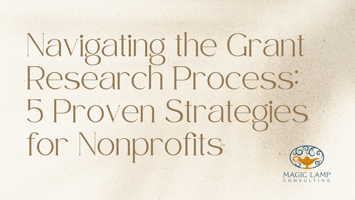Navigating Tight Budgets: Tips for Nonprofits in Resource-Constrained Environments

Nonprofits are no strangers to the challenges posed by tight budgets. Operating in resource-constrained environments requires resilience, strategic planning, and a commitment to maximizing impact with limited resources. In this blog, the Magic Lamp Consulting team has gathered practical tips and strategies to help nonprofits continue to deliver on their missions and create positive change in their communities, even with budget constraints.
Prioritize and Focus on Core Initiatives
In a tight budget scenario, it's essential to identify and prioritize core initiatives that align closely with your organization's mission. Conduct a thorough assessment of your programs and projects, distinguishing between mission-critical and auxiliary activities. By focusing on the core initiatives, you can allocate resources more efficiently and ensure that your organization's impact remains robust even in challenging financial circumstances.
Strategic Partnerships and Collaborations
Leverage the power of collaboration by forming strategic partnerships with other nonprofits, community organizations, or businesses that share similar goals. Pooling resources and expertise allows organizations to achieve collective impact, often more effectively than working in isolation. Collaborations can lead to shared costs, expanded reach, and innovative solutions that might be beyond the scope of individual organizations.
Embrace Technology for Efficiency
In the digital age, technology can be a powerful ally for nonprofits seeking to do more with less. Explore cost-effective software solutions that can streamline administrative tasks, enhance communication, and automate routine processes. Cloud-based tools and project management platforms can improve efficiency, allowing your team to focus more on mission-driven activities rather than getting bogged down by manual tasks.
Diversify Funding Streams
Relying on a single source of funding can be precarious, especially in resource-constrained environments. Diversifying your funding streams can provide stability and resilience. Explore different avenues such as individual donations, grants, corporate sponsorships, and fundraising events. Each source contributes to a more balanced financial portfolio, reducing the impact of fluctuations in any one area.
Engage in Outcome Measurement and Impact Evaluation
Demonstrating the impact of your programs is crucial for maintaining donor trust and attracting new supporters. Invest in outcome measurement and impact evaluation processes to showcase the tangible results of your efforts. Clear evidence of success can strengthen your case for continued funding and foster a sense of confidence among donors that their contributions are making a real difference.
Community Engagement and Volunteerism
Tap into the power of community engagement and volunteerism to extend the reach of your programs without a significant financial burden. Engaged community members can contribute their time, skills, and resources to support your initiatives. Establish strong volunteer programs, organize community events, and create opportunities for community members to actively participate in and contribute to your organization's mission.
Continuous Training and Skill Development
Invest in the professional development of your team to enhance their skills and capabilities. Well-trained staff can often find more efficient and innovative ways to operate within tight budgets. Look for low-cost or free training opportunities, and encourage a culture of continuous learning within your organization. Empower your team to adapt to evolving challenges and leverage their expertise to find cost-effective solutions.
Negotiate and Seek In-Kind Support
Don't be afraid to negotiate with vendors and service providers to secure favorable terms or discounts. Many businesses and individuals are willing to contribute in-kind support, offering services, expertise, or goods at reduced or no cost. Negotiating and seeking in-kind support can significantly stretch your budget, enabling your organization to access valuable resources without the associated financial burden.
Remember, facing budget constraints is not a sign of weakness but an opportunity to showcase resilience and ingenuity. As you implement these strategies, stay focused on your mission, communicate transparently with stakeholders, and foster a culture of adaptability within your organization. Tight budgets may present challenges, but with the right strategies, nonprofits can emerge stronger and more effective in their quest to create positive change in the world.




